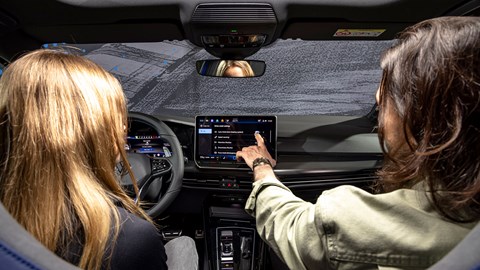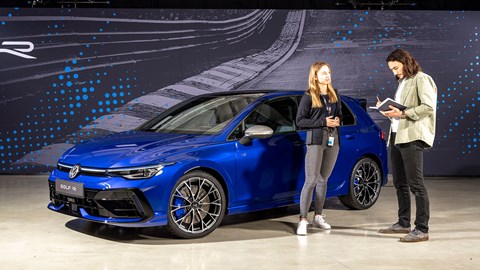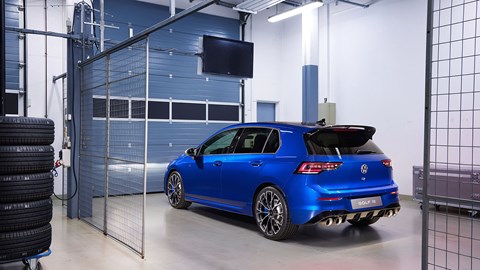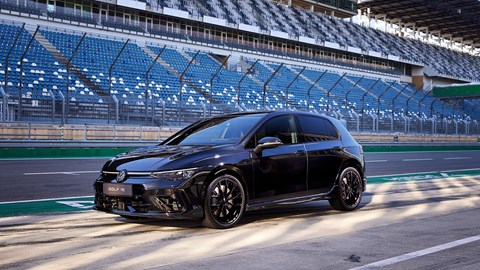► Volkswagen has mended the Golf R
► Gains lots of little interior improvements
► Plus, it gets a dash more power and anti-lag!
We’ve always liked the Volkswagen Golf R, but it’s always been plagued with irritating problems that made it downright infuriating to live with. Volkswagen has looked upon our frustrations with pity, though, and launched an updated version of the car which it says is sharper, faster and – crucially – more user-friendly.
Don’t adjust your screens. This is the facelifted version of the car – but the styling changes are so subtle that we reckon Volkswagen’s own design team would struggle to tell it apart from the old Golf R at 20 feet. The tweaks stretch as far as a lightly massaged front bumper, some new alloys and a shrewd head- and taillight redesign.
The revised Golf R will hit UK showrooms in autumn 2024, rejoining a rapidly shrinking pool of super hatchbacks that includes the BMW M135i, Honda Civic Type R and the fire-breathing Mercedes-AMG A 45. Scroll down to learn everything about the car or, if you want to know what the new car’s like to drive, check out our Golf R prototype review.
So, what’s changed over the old Golf R?
We’ll start with the interior, because that’s where you can see the changes most plainly. The most obvious difference over the old car is the new 12.9-inch touchscreen – and were happy to report it’s a huge improvement over the outgoing model’s disobedient, dawdling, dim-witted Casio calculator of an infotainment system.
Not only does it have far superior graphics, but it also has lightning-fast processors. That means it can now keep pace with your commands. Plus, it shares its menu design with the latest Passat, which we think should be hailed as the textbook example of sensible Germanic thinking.

The icons are massive (which makes them easy to hit on bumpy roads), there’s loads of contrast (which means it’s a doddle to quickly scan the screen and spot the widget you want) and you now get a fixed climate hot bar that allows you to quickly adjust things like the air conditioning and heated seats.
Look carefully at the top of the screen, too. There’s a little car icon that takes you directly to the driver assistance menu, where you can disengage lane assist with a single poke. That’s blissful. You had to cycle through half a dozen menus to switch it off in the previous version of the car.
Volkswagen has fettled the R’s steering wheel, too – just not in the way you might expect. The revised Golf GTI received an all-new wheel with physical buttons in place of the old car’s touch-sensitive sliders. However, Volkswagen tells us it was too expensive to fit the same wheel to the R, simply because it doesn’t have space for an ‘R’ button.

But the placement of the R button was one of our biggest issues with the previous Golf R. It falls right under your palms when you’re driving with your hands at 9 and 3 (which is where they should be when you’re pushing on), meaning we’d always unintentionally change drive modes on a twisty stretch of road.
To fix the issue. Volkswagen adjusted the amount of pressure required to operate the button. Now, the ‘R’ mode switch acts more like a physical button rather than a haptic one – you need to hammer your thumb into the switch with the force of a hydraulic press rather than tickle it like you’re petting a new-born pup.
Anything changed under the skin?
Again, Volkswagen’s updates are quite subtle. You get the same turbocharged 2.0-litre four-cylinder petrol engine as before, although it does have ever-so slightly more poke. Power has crept up from 316bhp to 328bhp which, being honest, isn’t really enough for you to notice the difference.
What’s more interesting is Volkswagen’s new wastegate map. The company’s software wizards have fiddled with the R’s throttle management and boost controller to force the turbo to hold more pressure when you lift off the throttle. The aim is to reduce lag and improve throttle response, allowing you to use more of the engine’s performance more of the time. And, hells bells, does it work well.
You can learn more about how it feels to drive by reading our Golf R prototype drive, but we’ll give you a brief rundown of the sensation here. With the tech engaged, the Golf R’s resting boost pressure jumps from 4psi to 11psi (which is a massive increase) and the throttle is far more fervent in the lower half of the rev-counter.

If you switch the car into R mode on the move, you can also feel the engine race forward as the new map rams extra boost pressure down the engine’s gullet. It’s like anti-lag lite.
The Golf R’s chassis hasn’t changed much save for a dash of recalibration, but Volkswagen has given it a fresh set of lightweight forged 19-inch alloy wheels. They’re available as an optional extra, and they shave around 8kg off the car’s kerb weight.
What else should I know?
To celebrate the launch of the facelifted car, Volkswagen has introduced a new Black Edition trim level. No prizes for guessing what that entails. It has black paint, black wheels, black brake calipers, black badges and privacy glass. Oh, and it’s also had its speed limiter raised from 155mph to 167mph.

The Black Edition will be a limited run special, which will be available from when the revised car is launched in autumn until the end of 2025. Prices haven’t been officially released, but Volkswagen’s top brass tells us it’ll cost around €4,000 (around £3,400) more than the standard car.